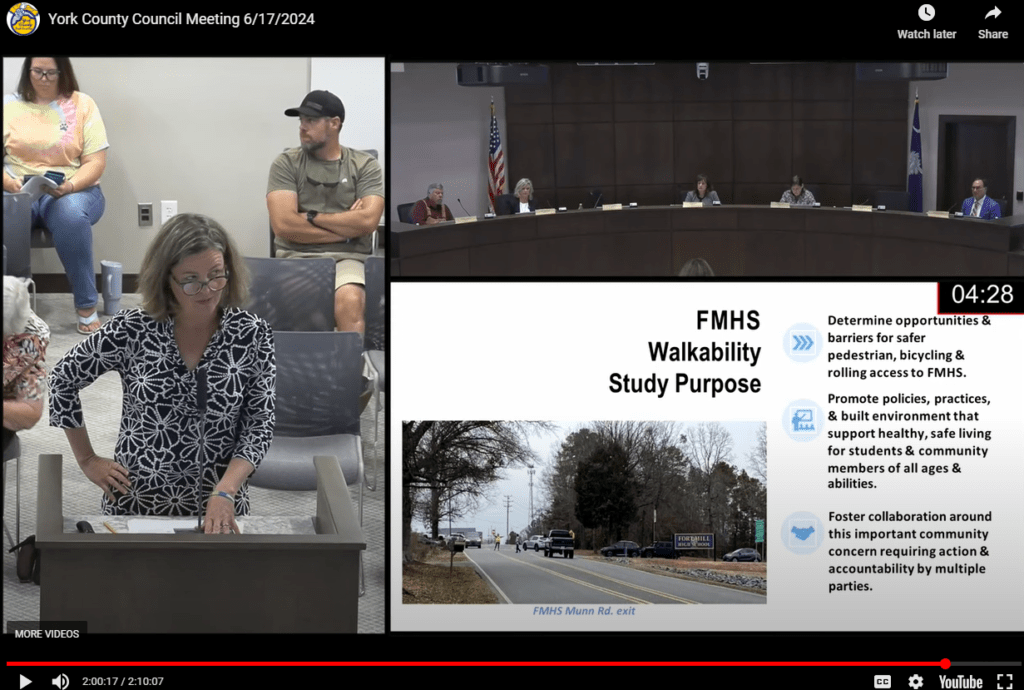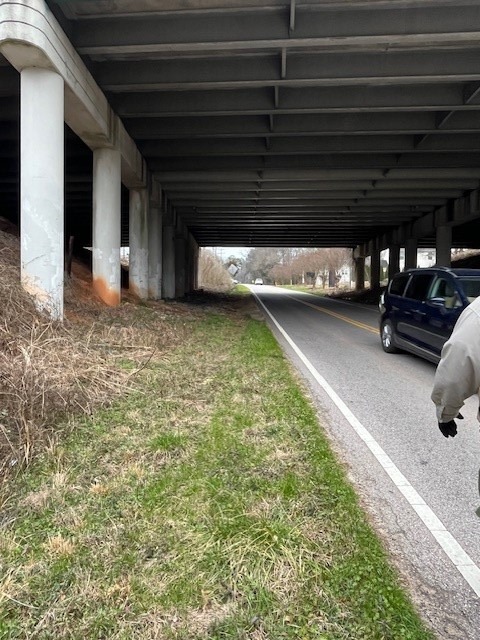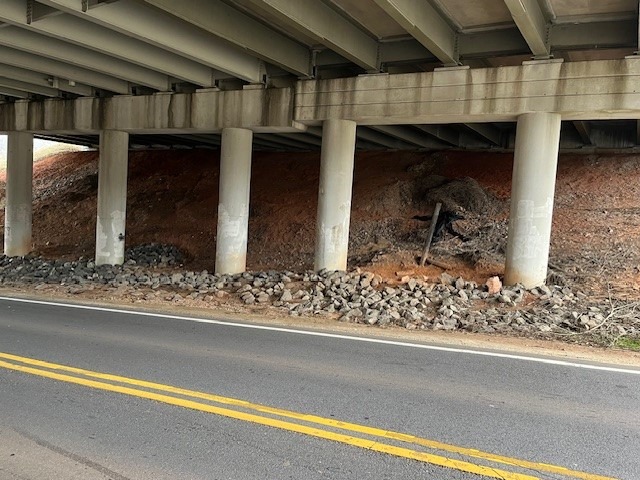Over two dozen community members walked four Fort Mill High School-area neighborhood routes on February 9, 2024. We were looking for ways to make it safer for students to walk, bike, and roll to school. Besides safety, we wanted to improve recurring traffic congestion and air quality at this high-impact location (by Kingsley, Baxter Village, Piedmont Hospital, Peach Stand, Harris Street Park, Walter Elijah Park, I-77, Hwy 21, Hwy 160, and Sutton Road).
Working with the school district, municipal, county and state staff, law enforcement, community coalitions, agencies and nonprofits, and concerned parents, we made multiple recommendations. Some fixes will need planning, funding, work by multiple parties, and time, and sometimes public buy-in will be needed. But others can be done ASAP to enhance student and community member safety.

The School Community Asked for Help
For years, school community members have requested safety improvements for students walking to school. They worry about few pedestrian or bicycle pathways, busy streets, and less-experienced drivers around the high school.
In 2023, parents organized and asked for help from policymakers at the school district, Town of Fort Mill, and RFATS metropolitan planning organization policy committee which includes the South Carolina Department of Transportation (SC DOT).
The Bike/Ped Coalition of York County (BPC) supported their efforts, lamenting that the SC DOT defunded its Safe Routes to School Program in 2019. We believe that:
Students need to be able to walk and roll to Fort Mill High safely – for transportation, physical and mental health, and a sense of community. Other benefits are less vehicular congestion, a cleaner environment, more local pride, economic development, general safety with more “eyes on the street,” higher property values, and health equity – valuable given neighboring lower-income communities.
Liz Duda
Specific concerns that the BPC heard were:
- Teachers over the years have requested safety improvements for students walking to the high school, worried about the lack of pedestrian pathways and busy streets.
- One school constituent expressed concern for the safety of students walking on Hwy 21 to the Forest Ridge Apartments, after exiting from the FMHS Harris Rd. exit.
- Another worried about students walking east to school on Harris Rd. crossing under the I-77 bridge (pictured below). This is the route that parents spoke to policymakers about needing a sidewalk – from the school’s Harris Rd. exit, west along Harris Rd., then north along Sam Smith Road, which passes multiple neighborhoods with students who should be able to walk and roll to school safely. (If working with multiple Sam Smith Road homeowners to put a sidewalk on their property proves too challenging, a transportation planner suggested adding a sidewalk along Harris Rd. to Sutton Rd.)
FMHS Walkability Study
The BPC partnered with Wholespire York County and SC DHEC to propose a walkability study – just as we have done in Clover, Rock Hill, Tega Cay, and York in the past. We aimed to:
- find opportunities and barriers for safer pedestrian, bicycling, and rolling access to Fort Mill High;
- support and promote policies, practices, and a built environment that support healthy, safe living for students and community members of all ages and abilities; and
- foster collaboration around this important community concern requiring action and accountability by multiple parties.
Our study looked at land uses; public transportation; street characteristics; quality of the environment; and places to walk or bicycle. We observed and analyzed existing infrastructure and amenities. We considered sidewalk availability, road conditions, shoulders, crosswalks, lighting, and pedestrian amenities. We used the St. Louis University School of Public Health’s Active Neighborhood Checklist.
Significant Demand for Walking and Rolling around FMHS
There is huge demand for the school community to be able to walk, bike, and roll safely to and around FMHS.
Of the approximately 2,000 students that attend FMHS, roughly 1,100 (over half!) live within one mile and 200 within ½ mile. Students, teachers, and administrators drive about 1,000 cars to school; there are around 990 morning bus riders; and an estimated 30-50 students walk or bike home from school. Buses serve every neighborhood because the school is not considered safely accessible on foot. Students who live across Hwy 21 are zoned for a different high school because it is not considered safe to cross the road.

Besides demand from students who live nearby, FMHS cross country/track athletes may run only on sidewalks and crosswalks, which limits neighborhood routes. Teachers and parents, starting at the school, also run in the neighborhood for exercise. The school hosts athletic and community events which may be accessed by foot at unofficial overflow parking across Munn Rd.
Report Recommendations
Our #1 recommendation was that the FMSD, Town of Fort Mill, York County, and SC DOT continue to collaborate to make the school and surrounding neighborhoods safely walkable and rollable.
We also recommended that the FMSD set target numbers for students regularly walking and rolling to school, given the large numbers who live close to the school.
SHORT TERM: We recommended some easier fixes ASAP to the state roads that serve FMHS:
- Immediately assess and fix the signage along Harris Rd., Munn Rd., and Sam Smith Road to ensure appropriate Speed Limit, Special School Speed Zone, and crosswalk notifications.
- Immediately mitigate the hazards along Harris Rd. where students walk and which is treacherous since there is no shoulder, sidewalk, or safe pathway to include:
- clearing debris and adding lighting under the I-77 bridge; and
- addressing the ditch in front of Sutton Mill adjacent to the road.
MEDIUM TERM: We suggested prioritizing these improvements that could take more work and time:
- Formalization and encouragement of the students walking to school via Epps Road and crossing at the school’s Harris Rd. entrance as the safer alternative to Hwy 21.
- On Harris Rd., this includes Speed Limit and Special School Speed Zone signage; speed enforcement; a crosswalk, preferably with LED lighting; a median pedestrian refuge island; and exploration of other traffic-calming measures.
- On Epps Road, we suggest working with the property owner to add a formal entryway to the Forest Ridge Apartments “goat path;” adding street lighting; and a lower speed limit.
- The pursuit of multiple measures to enhance the safety of students walking, running, and rolling on Munn Rd. including median pedestrian refuge islands; crosswalk paint, signage, and other visibility enhancements; exploration of other traffic-calming measures (see US DOT or Global Designing Cities); and sidewalk maintenance and repair.
LONG-TERM: Our final recommendations will take more time, funding, and cooperation, but could have a big community impact:
- Consider where bike lanes or a multi-use path can be added along Harris Rd., Munn Rd., and Sam Smith Rd., tying into the bike route on Hwy 21 and Sutton Rd.
- Evaluate the installation of a multi-use path along the school property east of Munn Rd. from Harris Rd. then continuing along private property or the road (with barriers) to Hwy 160.
- Continue the Harris Rd. north-side sidewalk from the school property, connecting to the Sutton Mill sidewalk, continuing past Sam Smith Road, to Sutton Rd.
- Explore the viability of an adjacent pathway from Harris Rd. to the Wimbleton Woods neighborhood as a pedestrian alternative to Sam Smith Road.
- Add a sidewalk on Harris Rd. south side to pass in front of the Rea Circle and Fort Mill Townhomes to let people on foot safely access Hwy 21 and Harris St. Park, preferably at least from Epps Road.
We Are Sharing the Message
You can hear our presentations to the policymakers in hopes that they will continue the collaboration and help:
- 3/11/2024 Town of Fort Mill meeting, Gretchen Benner
- 4/26/2024 RFATS Policy Committee meeting, Dr. David Keely & Liz Duda
- 5/20/2024 Tega Cay City Council meeting, Liz Duda
- 6/4/2024 Fort Mill School District Board meeting, Grey Young
- 6/17/2024 York County Council meeting, Liz Duda
We believe we will be presenting at an upcoming Fort Mill town Council meeting also.

And you can read our full March 11, 2024, report.
Killing of Crossing Guard Prompts Policymakers to Ask SCDOT to Help
Municipalities and school district formally asked for SCDOT help to make the roadways by our public schools safer after Crossing Guard Stanley Brucker was killed working on the road outside of Fort Mill Elementary a couple of weeks after we finalized our report.
- Fort Mill School District Board called a special meeting to approve “a resolution to South Carolina Department of Transportation” on 4/12/2024
- FM Town Council approved a resolution “to request the South Carolina Department of Transportation to review signage, signals, and any other safety measures at all school sites within the Fort Mill School District” on 4/8/2024
- Tega Cay City Council approved a resolution “to request the South Carolina Department of Transportation to review signage, signals, and other traffic control and safety measures along state roads at all school sites and pedestrian crossings within the City of Tega Cay” on 4/15/2024
Working together, we can make a difference for the Fort Mill High School students and community members.



